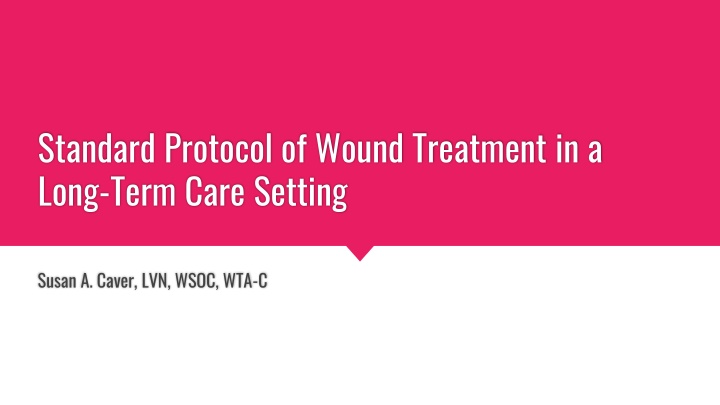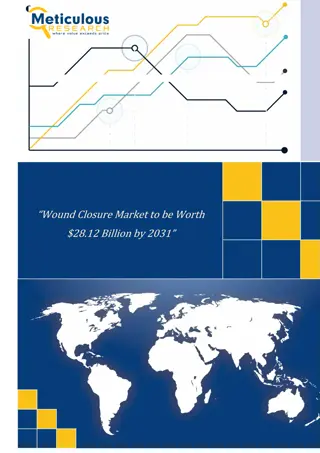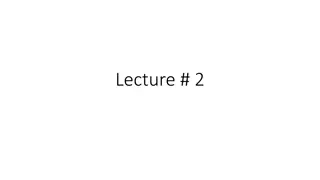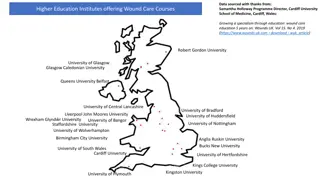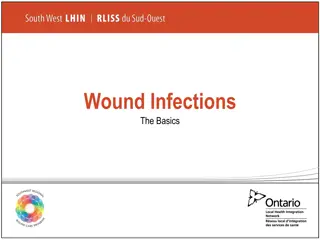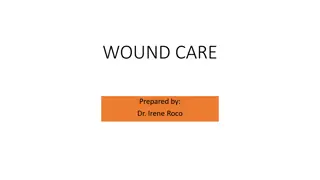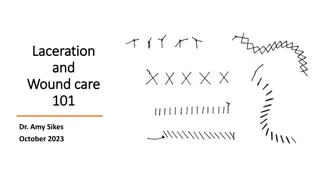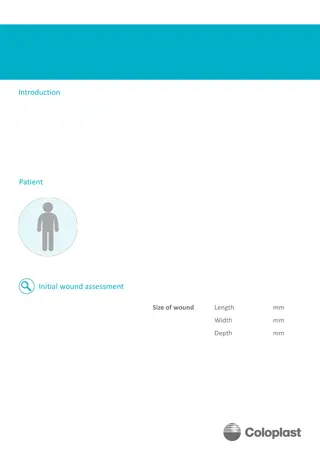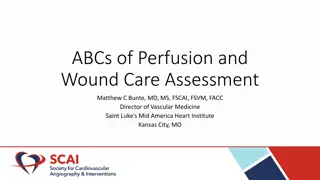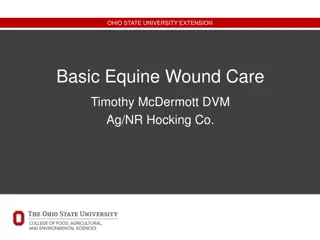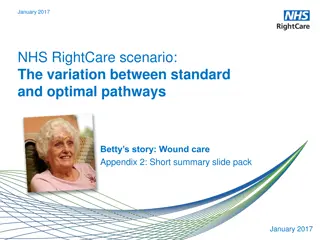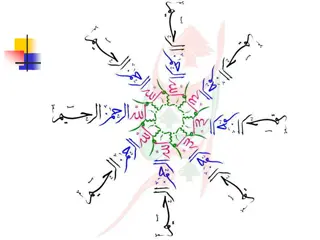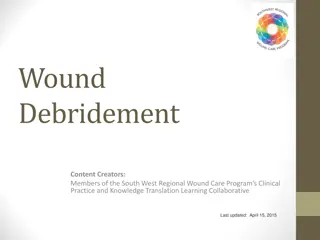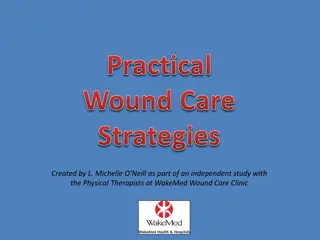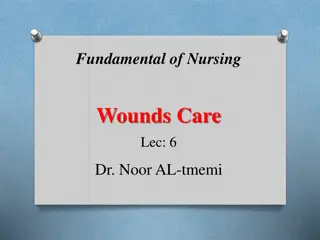Standard Protocol of Wound Treatment in Long-Term Care
In a long-term care setting, it's crucial to follow a standard protocol for wound treatment. This includes assessment, prevention, interventions, and documentation. Administrators should ensure licensed nurses conduct regular skin assessments and develop personalized care plans to address residents' skin integrity risks. By proactively identifying issues and implementing tailored interventions, the overall well-being of residents can be maintained effectively.
Download Presentation

Please find below an Image/Link to download the presentation.
The content on the website is provided AS IS for your information and personal use only. It may not be sold, licensed, or shared on other websites without obtaining consent from the author.If you encounter any issues during the download, it is possible that the publisher has removed the file from their server.
You are allowed to download the files provided on this website for personal or commercial use, subject to the condition that they are used lawfully. All files are the property of their respective owners.
The content on the website is provided AS IS for your information and personal use only. It may not be sold, licensed, or shared on other websites without obtaining consent from the author.
E N D
Presentation Transcript
Standard Protocol of Wound Treatment in a Long-Term Care Setting Susan A. Caver, LVN, WSOC, WTA-C
Course Objectives: At the end of the course, the Adult Residential Facilities (ARF) administrator should be able to identify these procedures and staff duties when dealing with wound injuries and skin breakdown in a long-term care setting and ensure that they are followed by the designated employees: 1.Assessment 2.Prevention 3.Interventions 4.Documentation
Assessment What should be done?
The administrator should supervise and ensure that: 1. The licensed nurse will complete a skin assessment, along with risk assessment using standardized risk assessment tool, on each resident upon admission. Thereafter, a risk assessment, will be completed weekly for the first four weeks after admission and then quarterly or when there is a significant change in condition, (as defined by MDS 3.0).
The administrator should supervise and ensure that: This proactive and ongoing approach ensures that potential issues related to skin integrity are promptly identified and addressed, contributing to the overall well-being of the residents. Furthermore, these assessments serve as the foundation for personalized care planning to address the identified risks. The licensed nurse is tasked with developing a comprehensive care plan tailored to each resident's specific needs and potential vulnerabilities related to skin breakdown. This involves a holistic consideration of factors such as mobility, nutrition, and overall health, aiming to prevent the development of pressure injuries and maintain optimal skin health. By coupling initial and ongoing assessments with individualized care planning, healthcare providers can effectively mitigate the risk of skin-related complications and provide tailored interventions that enhance the overall quality of care for residents.
The administrator should supervise and ensure that: 2. The licensed nurse will develop a care plan to address resident risk for skin breakdown. This involves translating the findings from the initial and ongoing skin assessments into a proactive and individualized strategy. The care plan should encompass various factors such as mobility, nutrition, and potential health issues that may contribute to skin integrity concerns. By addressing these factors proactively, the care plan serves as a roadmap for preventing and mitigating the risk of skin-related complications, ensuring comprehensive and personalized care for residents.
The administrator should supervise and ensure that: 3. The licensed nurse will assess each resident s skin condition weekly and document findings in weekly wound report. These assessments require meticulous documentation of findings in a weekly wound report, providing a continuous and detailed overview of the resident's skin health. This consistent monitoring allows for the early identification of any changes, enabling prompt intervention and adjustments to the care plan as needed. The weekly skin condition assessments contribute to a proactive approach in maintaining and improving skin integrity, emphasizing the importance of ongoing vigilance by the healthcare team.
The administrator should supervise and ensure that: 4. The licensed nurse will assess residents for pain related to pressure injury before and after treatment. This involves a comprehensive evaluation of pain levels, considering individual pain thresholds and responses. By integrating pain assessment into the care routine, the nurse can ensure that residents receive appropriate and timely pain management interventions, contributing to their overall comfort and well-being throughout the treatment process.
The administrator should supervise and ensure that: 5. The licensed nurse will use an interdisciplinary approach to facilitate care plans and progress notes will resident s status and appropriate interventions. This collaborative method involves healthcare professionals from various disciplines working together to provide holistic care. By fostering communication and collaboration among team members, this approach ensures a comprehensive understanding of the resident's needs and facilitates coordinated interventions, ultimately improving the effectiveness of the care provided.
The administrator should supervise and ensure that: 6. The licensed nurse will attend weekly Interdisciplinary Team Meeting, and the team should educate the resident/ family on status of wound healing and prevention as well as the treatment plan.
The administrator should supervise and ensure that: In these meetings, the healthcare team collaborates to discuss and evaluate the resident's progress, treatment plans, and wound healing status. Moreover, the team is tasked with educating both residents and their families on the ongoing care, emphasizing transparency and ensuring that all stakeholders are informed about the resident's health status and the planned interventions.
The administrator should supervise and ensure that: 7. The licensed nurse and the Registered Dietitian will assess resident s medications, nutritional status, abnormal lab values, fluid intake, and weight changes if contributing to break in skin integrity.
The administrator should supervise and ensure that: By jointly evaluating these aspects, the healthcare team can identify and address potential nutritional factors that may impact the resident's skin health. This collaboration aims to provide a comprehensive understanding of the resident's overall health, ensuring that interventions are not only skin-focused but also consider broader health aspects.
The administrator should supervise and ensure that: 8. The licensed nurse will refer newly identified pressure injuries to the IDT meeting for further assessment and care planning. This step ensures that any emerging issues are promptly addressed through collective expertise, facilitating a collaborative decision- making process to provide the most effective and personalized care for the resident.
The administrator should supervise and ensure that: 9. The licensed nurse will document wound related clinic visit of the resident and obtain a copy of wound clinic s documentation related to wound on each visit.
The administrator should supervise and ensure that: This meticulous documentation ensures a comprehensive record of the resident's wound healing progress and any interventions provided during clinic visits. It also supports effective communication between different healthcare providers, promoting continuity of care and facilitating informed decision-making within the healthcare team.
Prevention What should be done?
The administrator should supervise and ensure that: 1. The IDT, licensed nurses, and CNAs will assure the following preventive measures for resident at risk for skin breakdown: a. Apply pressure redistribution device- Low Air Loss Mattress for residents with multiple stage 2, stage 3, stage 4, unstageable and immobile residents.
The administrator should supervise and ensure that: b. Provide a pressure-redistribution device such as gel cushions to chair/ wheelchair and limit to 1 hour, if resident if resident has pressure injury to sacrum or buttocks.
The administrator should supervise and ensure that: c. Turn and reposition resident in bed or chair if the resident cannot do so independently. In addition, use pillows, linen rolls, heel and elbow protectors, wedges to keep bony prominences from direct contact with another or from unrelieved pressure. Elevate offload heels often or as tolerated while in bed.
The administrator should supervise and ensure that: 2. Keep linens clean smooth and free of wrinkles. This ensures that the resident's skin is not exposed to unnecessary friction or irritation, minimizing the risk of skin breakdown. Simultaneously, the directive to keep the skin moisturized addresses dryness as appropriate, acknowledging the role of proper hydration in preventing skin issues. By incorporating these practices into the daily care routine, healthcare providers contribute to the overall well-being of residents and mitigate potential factors contributing to skin breakdown.
The administrator should supervise and ensure that: 3. Keep skin moisturize to prevent dryness as appropriate. This action is crucial in preventing prolonged pressure on specific areas, reducing the risk of skin breakdown. Additionally, it recommends the use of supportive measures such as pillows, linen rolls, heel and elbow protectors, and wedges to prevent direct contact between bony prominences, thereby alleviating pressure. Regular elevation and offloading of heels are also advised during bed rest, contributing to the overall preventive strategy against skin issues. This proactive repositioning and the use of supplementary supports demonstrate a commitment to maintaining skin integrity for residents at risk of skin breakdown.
The administrator should supervise and ensure that: 4. Develop a plan for urinary incontinence, bowel and bladder training, toileting. The development of a comprehensive plan for managing urinary incontinence, bowel issues, and bladder training, emphasizes a proactive approach to address these common challenges. By creating tailored strategies, healthcare providers can effectively manage and minimize the impact of incontinence, promoting skin health and preventing potential complications. This approach aligns with the overarching goal of preventive care, focusing on individualized interventions to enhance the overall quality of life for residents.
The administrator should supervise and ensure that: 5. Monitor nutrition intake and weight loss and provide intervention as applicable. This proactive monitoring allows for early identification of potential issues and enables timely intervention. By addressing nutritional concerns promptly, healthcare providers contribute to the prevention of skin breakdown, as proper nutrition plays a crucial role in maintaining skin health. This holistic approach integrates nutritional assessment into the broader strategy for preventing skin-related complications among at-risk residents.
The administrator should supervise and ensure that: 6. Maintain the head of bed at lowest degree of elevation consistent with medical conditions and other restrictions. This measure aligns with preventive care by reducing the risk of pressure on specific areas, contributing to overall skin health. The directive underscores the need for individualized care, recognizing that medical conditions and restrictions may vary among residents, requiring tailored approaches to prevent skin breakdown.
The administrator should supervise and ensure that: 7. Use lifting devices such as a trapeze, mechanical or electronic lifts or bed linen to move (rather than drag) the resident in bed who cannot assist during transfers and repositioning changes.
The administrator should supervise and ensure that: This approach minimizes the risk of friction and pressure during movements, aligning with preventive strategies. By opting for lifting devices over dragging, healthcare providers contribute to the prevention of skin breakdown and promote safe and comfortable transfers for residents, ensuring a proactive and compassionate approach to care.
Interventions What should be done?
The administrator should supervise and ensure that: 1. measures for residents at risk for skin breakdown. The nursing staff will take preventive
The administrator should supervise and ensure that: - The nursing staff will encourage dietary intake and increase fluids, if not contraindicated, nourishment or other supplements as recommended by the Dietitian. - CNAs will complete a body checks on resident during shower or bed bath, and report findings to the charge/ treatment nurse.
The administrator should supervise and ensure that: 2. Licensed nurse will do the following if pressure injuries are identified; - Assess the wound, notify MD and obtain treatment orders as indicated, notify the family or responsible party. - Update care plans, implement care plans and interventions - Document goal, progress and effect of the interventions.
The administrator should supervise and ensure that: - Monitor nutrition intake and weight loss - Encourage/ assist consumption of food and fluids, obtain food substitutes/alternatives or fluids that are refused. - Track effectiveness of treatment and notify MD for change in treatment orders, if wound is not healing in timely manner or within 2 weeks.
The administrator should supervise and ensure that: 3. For Stage 1 pressure injury, the licensed nurse notify the physician and obtain treatment order. Notify family/ responsible party of treatment plan and update care plan.
The administrator should supervise and ensure that: 4. For Stage 2 pressure injury, the IDT and licensed nurse will implement the following: - Notify the physician - Request treatment order if necessary; fortified food plan per dietitian recommendation, order of multivitamins / mineral supplements if deficiencies are suspected or identified per dietitian recommendation. - Notify family/ responsible party for treatment plan and update care plan.
The administrator should supervise and ensure that: 5. For Stage 3, 4 and Unstageable Pressure Injury, the licensed nurse will; - Notify the physician of the pressure injury and stage, request tx order as indicated. - Discuss w/ the physician the need for lab work such as pre- albumin, albumin or bmp - Consider the use of additional nutrition supplement such as zinc sulfate, vitamin C, MVI, per dietitian recommendation.
The administrator should supervise and ensure that: - Assess the need of additional positioning devices, consider the use of redistribution surface, or low air loss mattress. - If wound shows sign and symptoms of infection, notify MD or wound specialist. - Notify family/ responsible party of pressure injury and tx plan.
The administrator should supervise and ensure that: 6. Licensed nurse and social services will assess the resident for psychosocial needs to determine his/her ability to comprehend and motivation to adhere the treatment program. 7. Referral to Physical or Occupational Therapy for positioning, special devices and restorative plan.
What are the components of treatment orders, from pressure injury to other skin conditions? - Type of wound - Location of wound - Treatment to be used - Frequency of treatment - Time limit
Documentation What should be done?
The administrator should supervise and ensure that: Licensed nurse/ treatment nurse will document the status of injury site and effectiveness of the treatment for pressure injuries or other skin conditions at least every 7 days.
The administrator should supervise and ensure that: Documentation should address the following areas: 1. Site/ Location: body location, specific anatomical location 2. Size: length, width and depth measurements in centimeters
The administrator should supervise and ensure that: 3.Stage: stage 1,2,3,4, Unstageable or DTPI; no downstaging for stage 3 & 4. 4.Undermining/tunneling: describe present or absent, if present document in centimeters and the location involve using wound documentation clock.
The administrator should supervise and ensure that: 5. Drainage: describe the amount, type and odor as; Amount - small, moderate or heavy. Color - serous, sanguineous, serosanguinous, purulent, or none. Odor - none or present; if present describe as foul or mild.
The administrator should supervise and ensure that: 6. Surrounding Tissues: describe condition of surrounding skin. 7. Wound base/ color: describe tissue present in the wound. 8. Wound Status: improved, or no change or deteriorated.
The administrator should supervise and ensure that: 9. Treatment/ dressing: describe the type of treatment and the dressing applied. 10. Pain assess and document interventions to related pain.
The administrator should supervise and ensure that: Document when the pressure injury is closed and continue to monitor on routine basis for indications of the risk of reopening or new skin breakdown. Implement preventive measures and skin maintenance.
Sources Dreifke, M. B., Jayasuriya, A. A., & Jayasuriya, A. C. (2015). Current wound healing procedures and potential care. Materials science & engineering. C, Materials for biological applications, 48, 651 662. https://doi.org/10.1016/j.msec.2014.12.068 Marelli, A., Calwuaerts, A., Wagner, E., D'hollander, K., & Goudmaeker, S. (2018, June). Wound Care Protocol. https://bibop.ocg.msf.org/docs/29/L029NURM02E-P_Wound- Care-protocol_OCB_EN_2018.pdf.
